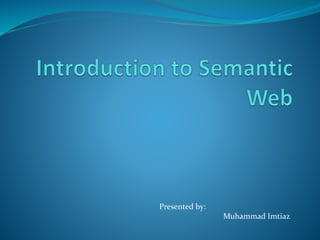
Semantic web
- 2. Web We Know Target consumers: humans web 2.0 mashups provide some improvement Rules about the structure and visualization of information, but not about its intended meaning Intelligent agents can’t easily use the information Granularity: document One giant distributed file system of documents One document can link to other documents Integration & reuse: very limited Cannot be easily automated Web 2.0 mashups provide some improvement
- 3. Limitations of Current Web Finding information Data granularity Resource identification Aggregation & reuse Data integration Inference of new information
- 4. The Need For Smarter Web The Semantic Web is an extension of the current web in which information is given well-defined meaning, better enabling computers and people to work in cooperation. The Semantic Web is a mesh of data that are associated in such a way that they can easily be processed by machines instead of human operators. It can be conceived as an extended version of the existing World Wide Web, and it represents an effective means of data representation in the form of a globally linked database.
- 5. Building Semantic Web The Semantic Web is driven by the World Wide Web Consortium (W3C). It builds on W3C's Resource Description Framework (RDF), and is usually designed with syntaxes that use Uniform Resource Identifiers (URIs) to represent data. These syntaxes are known as RDF syntaxes. The inclusion of data to RDF files enables computer programs or Web spiders to search, discover, collect, assess and process the data on the Web.
- 6. Goals Of Semantic Web The key goal of the Semantic Web is to trigger the evolution of the existing Web to enable users to search, discover, share and join information with less effort. The Semantic Web can be considered a vision for the future in which data could be quickly interpreted by machines, allowing them to carry out numerous tedious tasks related to discovering, blending, and taking action on the information available on the Web.
- 7. The Semantic Web Target consumers: intelligent agents Explicit specification of the intended meaning information Intelligent agents can make use the information Granularity: resource/fact One giant distributed database of facts about resources One resource can be linked (related) to other resources Integration & reuse: easier Resources have unique identifiers With explicit semantics transformation & integration can be automated
- 8. Vision of Semantic Web Data should be accessed using the general Web architecture (e.g., URI-s, protocols, …) Data should be related to one another just as documents are already Data to be shared and reused across Data to be processed automatically New relationships between pieces of data to be inferred
- 10. Resource Description Framework A simple data model for Formally describing the semantics of information in a machine accessible way representing meta-data (data about data) A set of representation syntaxes XML (standard) Building blocks Resources (with unique identifiers) Named relations between pairs of resources (or a resource and a literal)
- 11. RDF’s Advantages Simple but expressive data model Global identifiers of all resources (URIs) Reduces ambiguity Easier incremental data integration Can handle incomplete information. Graph structure Suitable for a large class of tasks Data merging is easier
- 12. RDF Schema RDFS provides means for: Defining Classes and Properties Defining hierarchies (of classes and properties) RDFS differs from XML Schema (XSD) Open World Assumption vs. Closed World Assumption RDFS is about describing resources, not about validation
- 13. URI Uniform Resource Identifier A simple and extensible means for identifying a resource A URL is a type of URI
- 14. Web Ontology Language (OWL) More expressive than RDFS Identity equivalence/difference same As, different From, equivalent Class/Property More expressive class definitions Class intersection, union, complement, disjointness Cardinality restrictions More expressive property definitions Object/Data type properties Transitive, functional, symmetric, inverse properties Value restrictions
- 15. RDFa RDFa provides a set of XHTML attributes that express RDF data. New standard for resource description and access designed for the digital world
- 16. Microformats Microformats are simple conventions for embedding semantics in HTML. These are designed first for humans and then for machines. No name spaces, no new tags Built Upon existing standards like vCard, iCalender etc.
- 17. HTML vCard represents people, companies, places, organizations. HTML iCalendar represents calendar events.
- 18. Summary “I have a dream for a web in which computer become capable of analyzing all the data on the web.” Tim Berners Lee – 1999 Inventor of the Web The Semantic Web is not a separate web but it is an extension of the current web.
- 19. At present, the Semantic Web is increasingly used by small and large business. Oracle, IBM, Adobe, Software AG, or Yahoo! are only some of the large corporations that have picked up this technology already and are selling tools as well as complete business solutions. The Semantic Web will provide an infrastructure that enables not just web pages, but databases, services, programs, sensors, personal devices, and even household appliances to both consume and produce data on the web. Software agents can use this information to search, filter and prepare information in new and exciting ways to assist the web user.